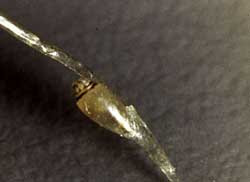Head lice and pubic lice nits
What are lice nits?
As every parent of a school-age child probably already knows head lice are tiny "bugs" that infest the scalp and cause a lot of itching and irritation. They can affect all kids, everywhere, and can be very contagious. They are, however, really (really!) less of a medical concern than many people believe, but that argument is for another blog article. This post is about the eggs, or nits, that lice lay and what exactly the nits look like.
Nit is another name for egg. Both head lice and pubic lice (a related species that infests areas of the body where course hair grows like the groin and chest) attach their nits to the hair of their hosts (see drawing above and photo below). The nits are actually glued to the hair shaft close to scalp because they need the warmth and moisture that comes off the scalp in order to develop properly. Nits are attached so tightly that normal washing, combing, or brushing won't remove them.
Nits hatch quickly (7-9 days) under normal conditions so any nit that is more then about an inch away from the scalp is probably already hatched or is dead. As the hairs grow the attached nits (alive or dead) move away from the scalp with the lengthening hair. There's some debate about how far away a live nit can be found from the scalp. Some people say 1/4" while others say "more than an inch". The difference probably depends on local climate and perhaps differences in lice populations. Regardless, just realize that it is difficult to tell the difference between live nits and dead or hatched nits.
 Effective lice control must include "nit-picking" and combing to crush or remove these eggs (see photo left). If lice eggs are not removed they will hatch in a few days and start the infestation all over again. Combing with the proper lice comb is the best way to remove nits and there are now effective combing aids that make this job easier. Use the links below for more information about lice and lice control.
Effective lice control must include "nit-picking" and combing to crush or remove these eggs (see photo left). If lice eggs are not removed they will hatch in a few days and start the infestation all over again. Combing with the proper lice comb is the best way to remove nits and there are now effective combing aids that make this job easier. Use the links below for more information about lice and lice control.
As every parent of a school-age child probably already knows head lice are tiny "bugs" that infest the scalp and cause a lot of itching and irritation. They can affect all kids, everywhere, and can be very contagious. They are, however, really (really!) less of a medical concern than many people believe, but that argument is for another blog article. This post is about the eggs, or nits, that lice lay and what exactly the nits look like.
Nit is another name for egg. Both head lice and pubic lice (a related species that infests areas of the body where course hair grows like the groin and chest) attach their nits to the hair of their hosts (see drawing above and photo below). The nits are actually glued to the hair shaft close to scalp because they need the warmth and moisture that comes off the scalp in order to develop properly. Nits are attached so tightly that normal washing, combing, or brushing won't remove them.
Nits hatch quickly (7-9 days) under normal conditions so any nit that is more then about an inch away from the scalp is probably already hatched or is dead. As the hairs grow the attached nits (alive or dead) move away from the scalp with the lengthening hair. There's some debate about how far away a live nit can be found from the scalp. Some people say 1/4" while others say "more than an inch". The difference probably depends on local climate and perhaps differences in lice populations. Regardless, just realize that it is difficult to tell the difference between live nits and dead or hatched nits.
 Effective lice control must include "nit-picking" and combing to crush or remove these eggs (see photo left). If lice eggs are not removed they will hatch in a few days and start the infestation all over again. Combing with the proper lice comb is the best way to remove nits and there are now effective combing aids that make this job easier. Use the links below for more information about lice and lice control.
Effective lice control must include "nit-picking" and combing to crush or remove these eggs (see photo left). If lice eggs are not removed they will hatch in a few days and start the infestation all over again. Combing with the proper lice comb is the best way to remove nits and there are now effective combing aids that make this job easier. Use the links below for more information about lice and lice control.


